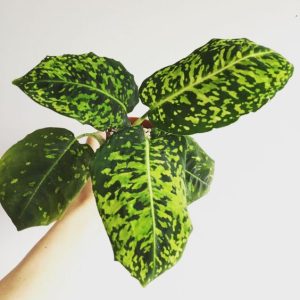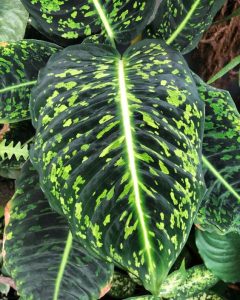Dieffenbachia Reflector

- Botanical Name: Dieffenbachia 'Reflector'
- Family Name: Araceae
- Stems: 6.5-10 inch
- Temperature: 15°C-26°C
- Other: Prefers warmth, tolerates partial shade.
Overview
Product Description
Dieffenbachia Reflector: The Majestic Indoor Powerhouse
Morphological qualities and development patterns
The Dieffenbachia reflector has thick, fleshy stems; the leaves are oval, dark green and lustrous. Its beauty value will be enhanced under the irradiation of light by the reflected effect created by the dispersed white or yellow dots and stripes in its leaves. Dieffenbachia resists high light exposure, is not cold-resistant, enjoys warm, humid, semi-shaded surroundings, and is scared of drought.Maintenance areas
 Light: One should avoid direct sunshine and choose a spot with enough dispersed light.
Light: One should avoid direct sunshine and choose a spot with enough dispersed light.
Temperature: Not less than 15℃ in winter; the most appropriate development temperature is 20℃–30℃.
Watering: Maintaining a wet soil, avoid water buildup to reduce root rot.
Apply liquid fertilizer once a month throughout the growing season; cut fertilizer use in winter.
Timely pruning may help to keep an attractive form and encourage plant branching.
Decorative influence
The dieffenbachia reflector has very nice ornamental impact. Its leaves’ color and sheen may be complemented with other interior design approaches. It may create a natural environment whether the style is traditional or contemporary and basic.
The Feng Shui impact
In Feng Shui, the may not only provide good fortune and luck but also fix negative airflow. Usually put in the wealth position of the house, it helps to increase money.
 Medicinal worth
Medicinal worth
There is some medicinal worth among many kinds of Dieffenbachia. Although the juice of certain types may be unpleasant, therefore be cautious when handling it; its leaves may be utilized for detoxification and heat cleansing.
Environmental flexibility
Strong environmental adaptation and tolerance to decreased light conditions define the Dieffenbachia reflector. It is appropriate for placing inside in areas lacking enough illumination.
Control of pests and diseases
Though the Dieffenbachia reflector is not easy to become ill, it is also essential to routinely examine the plant to identify and handle probable pests and diseases in time, including leaf spot disease and red spiders.
Corresponding competencies
The Dieffenbachia reflector may be coupled with other plants, including spider plants, green radish, etc., in interior design to create a rich feeling of layering and color contrast.
Reproductive technique
Cuttings are mostly used in replication of the Dieffenbachia reflector. After cutting the stem segment with three to four nodes, remove the lower leaves and place them into damp ground. Keep the suitable temperature and humidity; it will take root in three to four weeks.
Particular usage
Apart from being an interior decorative plant, the Dieffenbachia reflector may also be used as a component of courtyard greening or as a basis for plant walls. Its special reflecting effect may generate sun’s attractive light and shadow patterns.
One multifarious indoor plant is the dieffenbachia reflector. It may deliver lucky Feng Shui meanings in addition to beautify the surroundings and enhance air quality. It is fit for the décor of many inside environments and simple to maintain.
FQA
1.Is Dieffenbachia reflector rare?










